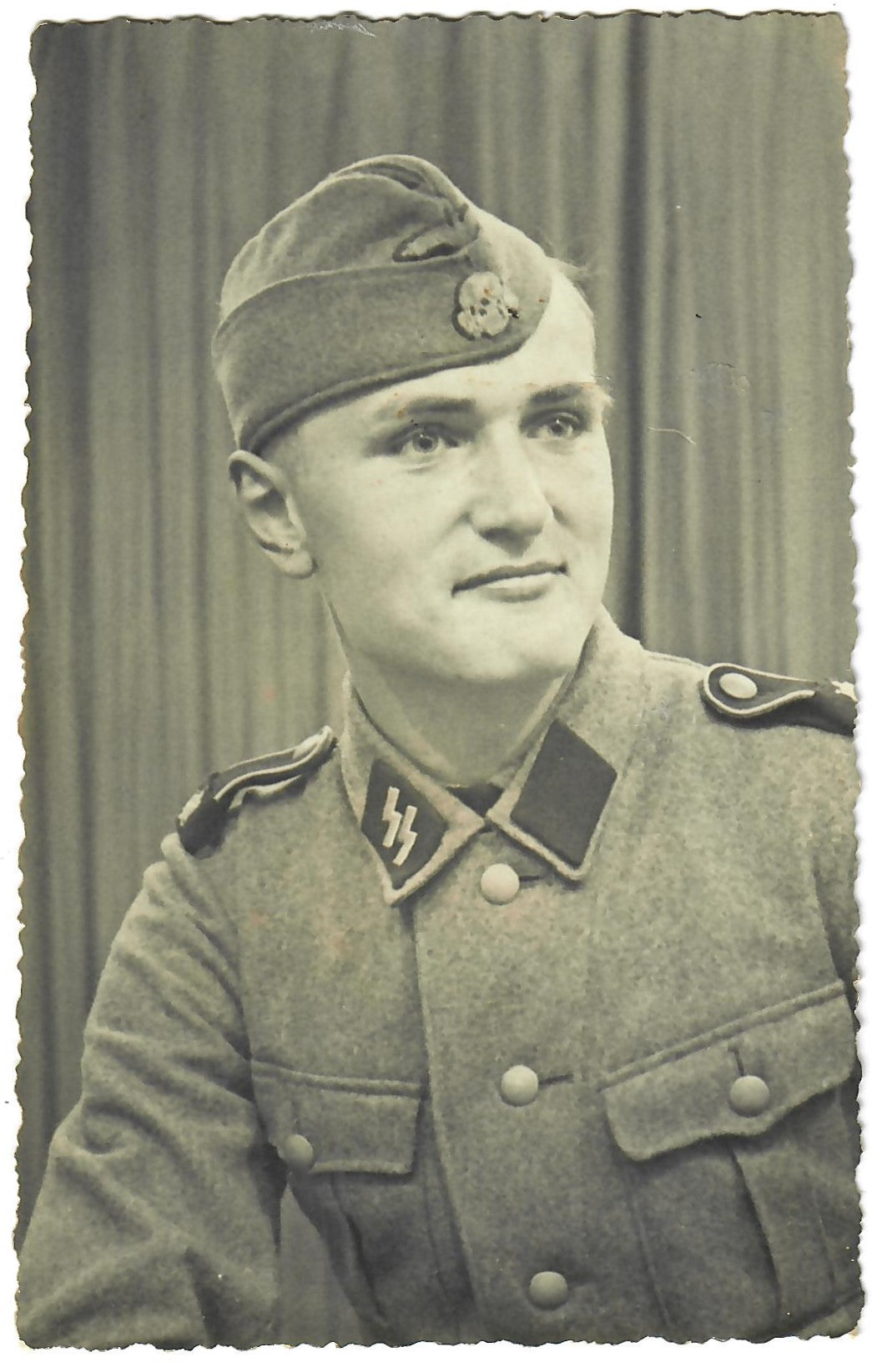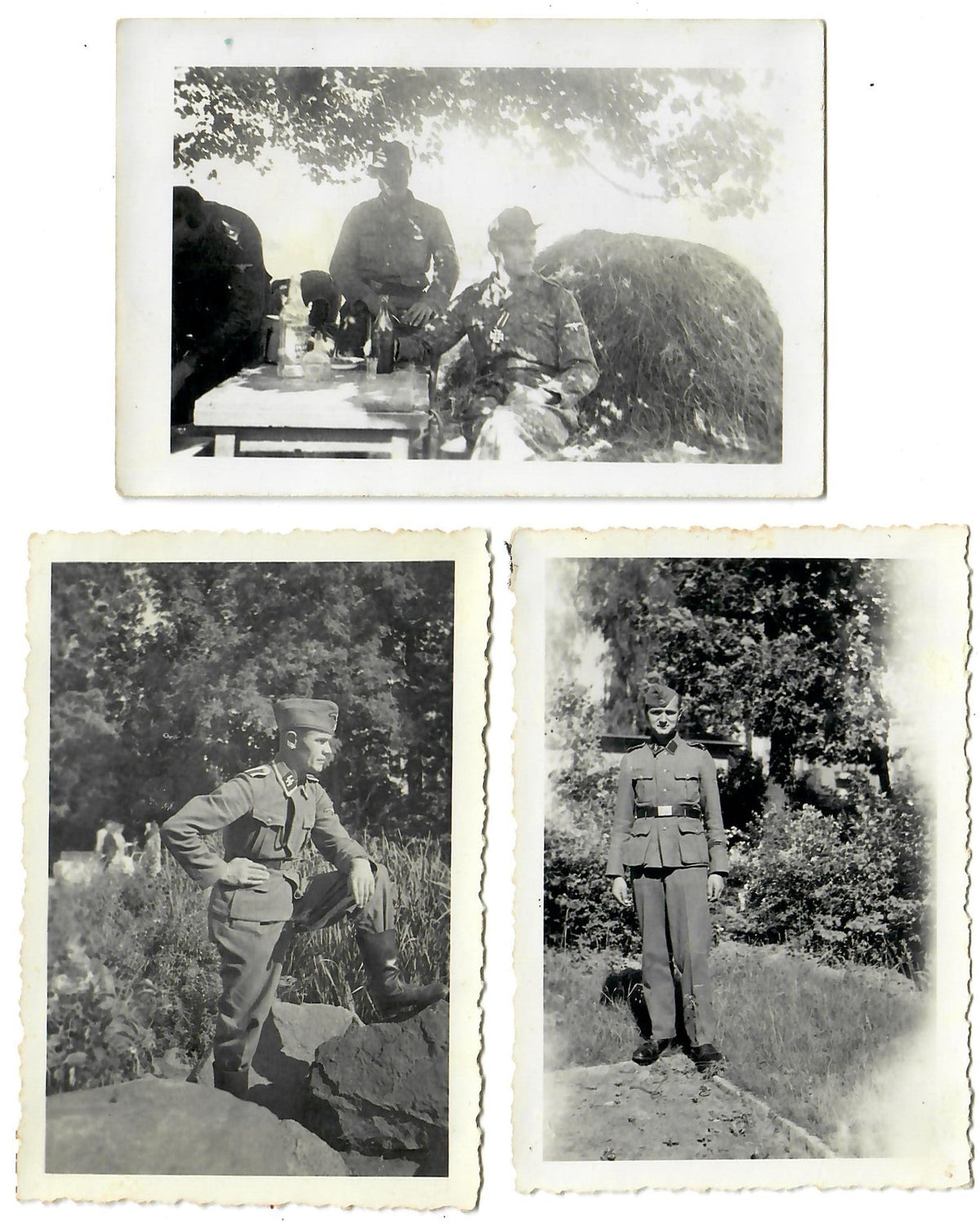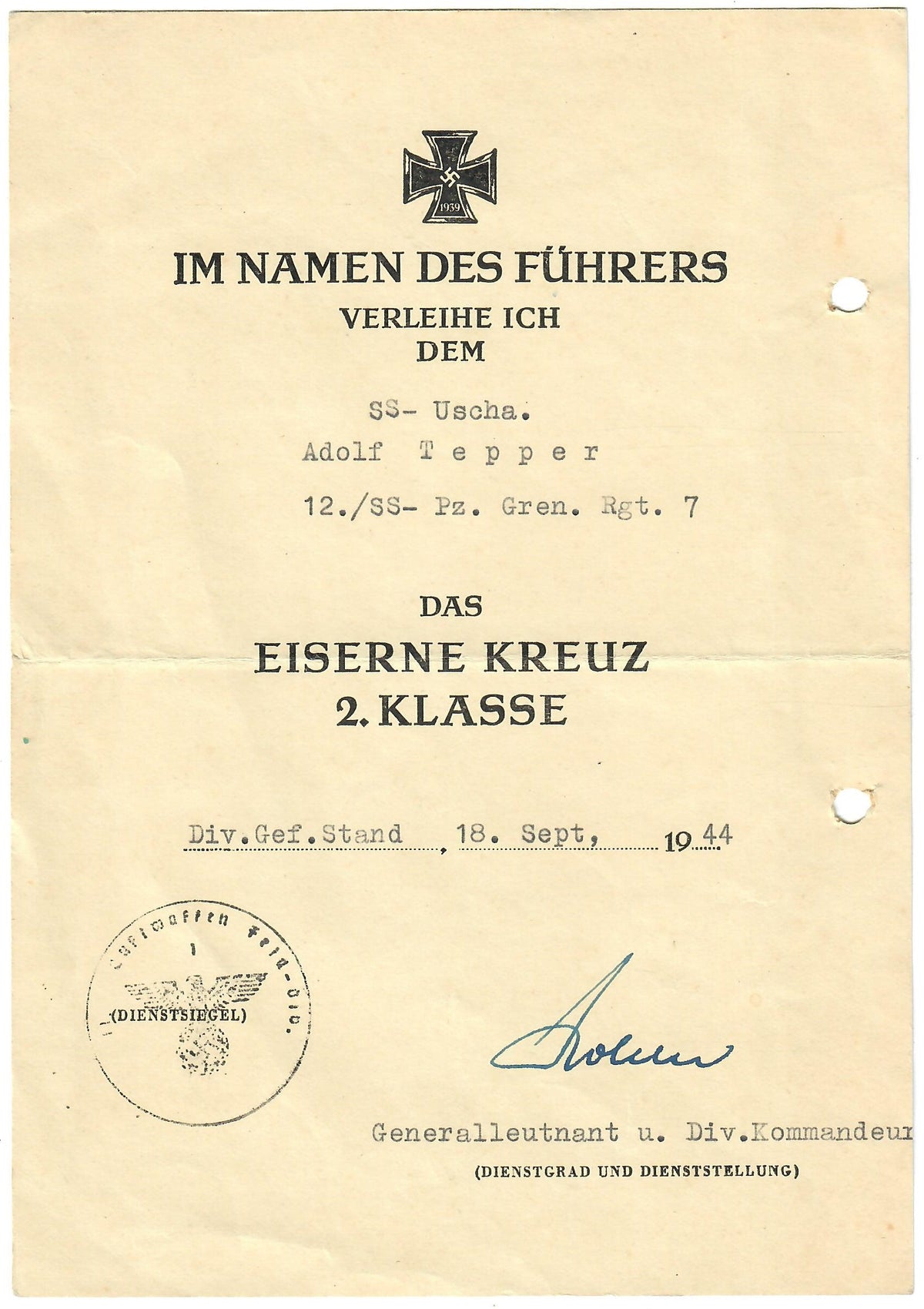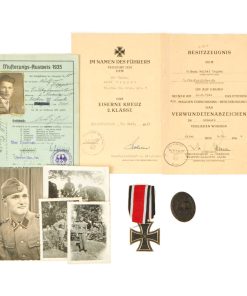Original German WWII Award, Document & Photo Set of Brothers Adolf & Walter Tepper – Both in Waffen SS Panzer Divisions Original Items
$ 1.195,00 $ 298,75
Original Items: One of a Kind Grouping. The SS (Schutzstaffel – ‘Protection Squadron’) was originally formed in 1925, ostensibly to act as a small, loyal bodyguard unit to protect the Führer, Adolf AH. Under the direction of the Reichsführer-SS Heinrich Himmler, the SS grew to be the most ruthless and feared organization of the 20th century. They were the vanguard of the NSDAP and eventually controlled nearly every function of German life and much of Occupied Europe.
When WWII began in earnest, the SS-Verfügungstruppe (SS-VT) (SS Dispositional Troops) became the Waffen-SS (“Armed SS”), an official military branch of the SS organization. Its formations included men from NSDAP ruled Germany, along with volunteers and conscripts from both occupied and unoccupied lands.
Here we have a lovely set of items from two brothers, Adolf & Walter Tepper, who both joined the Waffen SS during the war, both servicing in Panzer divisions during the war. The grouping contains photos, awards, and documents, and really has some fantastic research potential.
For Adolf Tepper, who we believe is the older brother, the grouping contains his original Muſterungs-Ausweis 1935 (Muster Identification 1935) from when he enlisted in 1935. This document has his picture, signature, and also indicates a date of 5. 7. 1935. As noted by the stamp in the lower right, at this time the army was still in the process of becoming part of the Wehrmacht, and it has a REICHSWEHR BESTELLE inspection stamp over a Weimar Eagle. We assume that Tepper enlisted at this point, and remained in service throughout the war, however there is unfortunately not any information regarding his service. There is however a photo of Tepper on his Waffen SS uniform as an enlisted man.
The other material we have related to Adolf Tepper is an Iron Cross 2nd Class 1939 award in very good condition, along with the original BESITTZZEUGNIS “possession/award” certificate. This indicates that the Iron Cross 2nd Class was awarded to SS- Uscha. Adolf Tepper on 18. Sept, 1944, and lists his unit as 12. / SS- Pz. Gren. Regt. 7. The rank of SS-Unterscharführer (SS-Junior section leader) was a Junior NCO rank equivalent to a Heer Army Unteroffizier, or U.S. Army Sergeant. The regimental designation indicates that Tepper was member of the 12th Company, 7th Panzer Grenadier Regiment is listed as being part of the 4th SS Polizei Panzergrenadier Division at this time. The document has the correct stamp, and is signed by a Generalleutnant u. Div. Kommandeur on the lower right.
Of note: Panzergrenadier regiments were motorized / mechanized infantry troops, and were legendary in the field. Originally called Schützen regiments, they had used the same Pink piping as the Panzer corps. Then in 1942 Infantry Regiments were renamed as Grenadier Regiments by Adolf H as a historical homage to Frederick the Great’s Army, and the Schützen were renamed to Panzergrenadiers.
The material we have from Walter Tepper includes three period photographs, and a Wound Badge in Black, along with the original BESITTZZEUGNIS “possession/award” certificate. This was awarded for a single injury received on 20. 8. 1944. He is listed at this time as ᛋᛋ Mann Walter Tepper, and is listed as being part of the 1. / Pz. N. A. L. ᛋᛋ. A. H., the infamous 1st SS Panzer Division Leibstandarte SS Adolf H****r. We assume that the “N. A.” stands for Nachrichten Abteilung (Signals Detachment), which should be the 1st SS Panzer Signal Battalion, in this case the first company. The award document bears the authorizing signature of a Senior Staff Surgeon & Chief Doctor, at Reserve-Lazarett Ahlen (Reserve Hospital Ahlen) and was awarded 6. 10. 1944. We assume that this wound may have taken him out of service for the rest of the war.
Both of the award documents measure approximately, 8″ x 5.5″, (20cm x 14cm), and are printed on mid-weight paper with black print and typed in particulars. All of the documents are dated, with their correct stamps and signatures. All documents are in good condition, with the expected wear and yellowing from age. They all show folding and light staining, as expected of documents of this age. Please consult the pictures for condition specifics.
A lovely set of awards and documents from two brothers in the Waffen SS, ready for further research and display!
There is no more iconic German military award than the Iron Cross (Eisernes Kreuz, abbreviated EK). The long history of this order began during the Napoleonic Wars. It was established by King Friedrich Wilhelm III of Prussia in March 1813, backdated to the birthday of his late wife Queen Louise on 10 March 1813 (EK 1813), who was the first person to receive this decoration (posthumous). The award criteria changed somewhat with time, but generally speaking, Iron Crosses could be awarded for individual acts of bravery, or for leadership achievements on the battlefield. The design was created by a Karl Friedrich Schinkel, his choice of the black cross with silver outline was derived from the heraldic emblem of the Teutonic Knights.
There were a number of different type and grades of Iron Cross awards throughout its long history, but the basic details of the most widely awarded grades: The Iron Cross 1st Class and Iron Cross 2nd Class- remained the same. The first class award was a breast badge, with fittings on the reverse to allow it to be worn on the uniform. These fittings varied widely over time and from maker to maker, and could be a simple in and catch, a screw post and retaining disc, or more elaborate setups. The second class award was suspended from a ribbon, originally in the Prussian colors of black and white, later in the Reich colors of black, red and white.
On the original versions of these crosses, in 1813, the front of the iron core of each grade was bare, and only the second class award had ornamentation: a crown over the initials “FW” representing the King, a sprig of oak leaves, and the date 1813. The core was redesigned in 1870, when the cross was re-instituted during the Franco-Prussian War. The reverse ornamentation on the Iron Cross 2nd Class remained the same, but the front of the core on both grades now bore another crown, a “W” representing Kaiser Wilhelm, and the date 1870. This pattern repeated again when the cross was reinstituted for WWI- everything stayed the same, only the date 1870 was replaced with 1914.
The final reinstitution of the cross came in 1939. For this version, the front of the core for both grades bore a swas and the date 1939. The oak leaves, crown and royal initials were removed from the reverse, with only the date 1813 remaining as a reminder of the legacy of this award. In WWII, hundreds of thousands of Iron Cross First Class awards were bestowed, and four and a half million Iron Cross Second Class awards. Iron Crosses were made by a large number of authorized manufacturers. Some variants of these awards were mass produced in huge numbers. Others were made in very limited quantities.
The Iron Cross was normally a military decoration only, though there were instances of it being awarded to civilians for performing military functions. Two examples of this were civilian test pilots Hanna Reitsch who was awarded the Iron Cross 2nd Class and 1st Class and Melitta Schenk Gräfin von Stauffenberg, who was awarded the Iron Cross 2nd Class, for their actions as pilots during World War II.
The Wound Badge (German: Verwundetenabzeichen) was a military decoration first promulgated by Wilhelm II, German Emperor on 3 March 1918, which was awarded to wounded or frostbitten soldiers of the Imperial German Army, during World War I. Between the world wars, it was awarded to members of the German armed forces who fought on the Nationalist side of the Spanish Civil War, 1938–39, and received combat related wounds. It was awarded to members in the Reichswehr, the Wehrmacht, SS and the auxiliary service organizations during the Second World War. After March 1943, due to the increasing number of Allied bombings, it was also awarded to wounded civilians in air raids. It was awarded when the wound was the result of enemy hostile action, with an exception being for frostbite.
The badge had three classes:
– Black (3rd class, representing Iron), for those wounded once or twice by hostile action (including air raids).
– Silver (2nd class) for being wounded three or four times.
– Gold (1st class, which could be awarded posthumously) for five or more times wounded.
The “progression” could be waived in the event of loss of a limb or eyesight; when such a severe wound occurred, the silver badge was awarded.
Fast Shipping with Professional Packaging
Thanks to our longstanding association with UPS FedEx DHL, and other major international carriers, we are able to provide a range of shipping options. Our warehouse staff is expertly trained and will wrap your products according to our exact and precise specifications. Prior to shipping, your goods will be thoroughly examined and securely secured. We ship to thousands clients each day across multiple countries. This shows how we're dedicated to be the largest retailer on the internet. Warehouses and distribution centres can be located throughout Europe as well as the USA.
Note: Orders with more than one item will be assigned a processing date depending on the item.
Before shipping before shipping, we'll conduct a thorough inspection of the items you have ordered. Today, the majority of orders will be delivered within 48 hours. The delivery time will be between 3-7 days.
Returns
The stock is dynamic and we cannot completely manage it because multiple stakeholders are involved, including our factory and warehouse. So the actual stock may alter at any time. It's possible that you may not receive your order once the order has been made.
Our policy is valid for a period of 30 days. If you don't receive the product within 30 days, we are not able to issue a refund or an exchange.
You can only return an item if it is unused and in the same state as the day you received it. You must have the item in its original packaging.
Related products
Uncategorized
Uncategorized
Uncategorized
Uncategorized
Uncategorized
Uncategorized
Uncategorized
Uncategorized
Uncategorized
Uncategorized
Uncategorized
Angolan Rebel 1970s era 60mm Inert Display Mortar from Angolan Civil War Original Items
Uncategorized
Uncategorized
Uncategorized
Armoured Fighting Vehicles of the World: AFVs of World War One (Hardcover Book) New Made Items
Uncategorized
Uncategorized
Uncategorized
Australian WWII Owen MK1 Machine Carbine SMG Custom Fabricated Replica with Sling Original Items
Uncategorized
Band of Brothers ORIGINAL GERMAN WWII Le. F.H. 18 10.5cm ARTILLERY PIECE Original Items
Uncategorized












































































